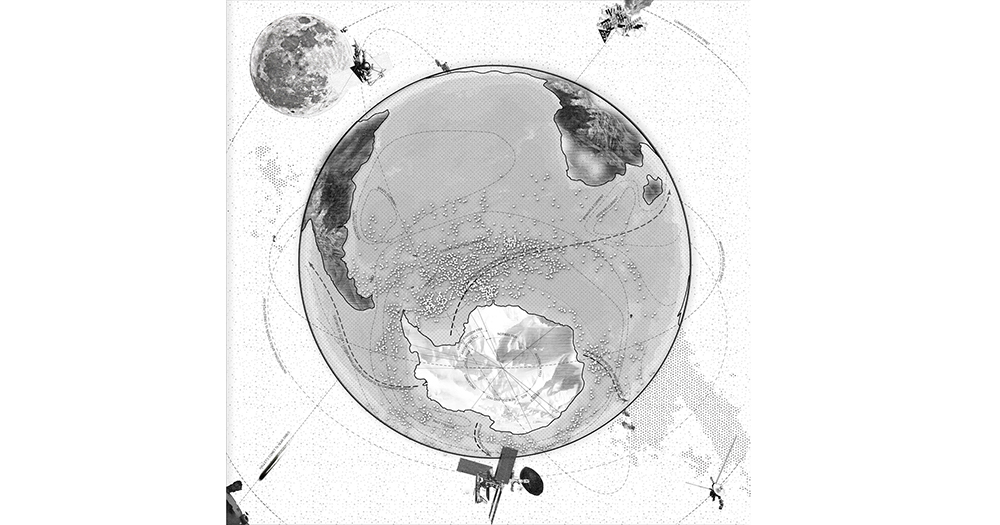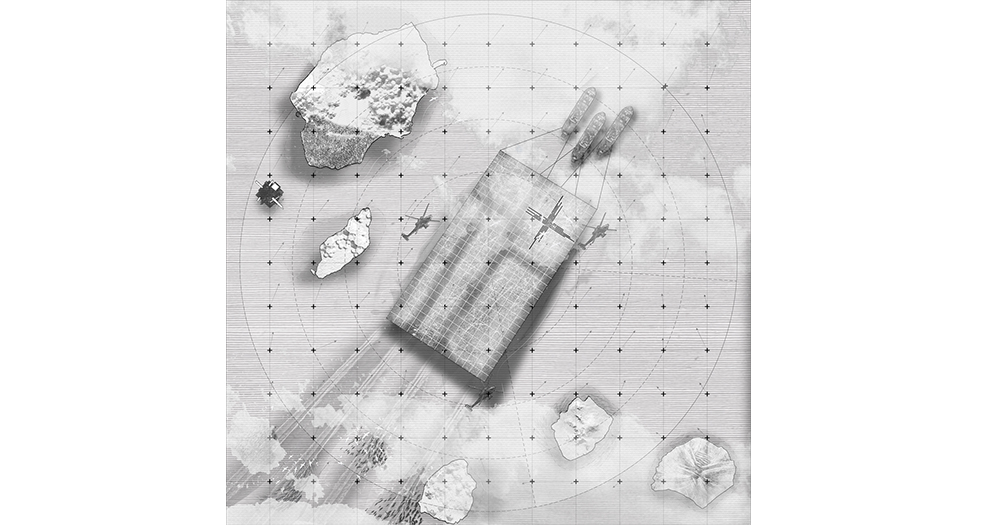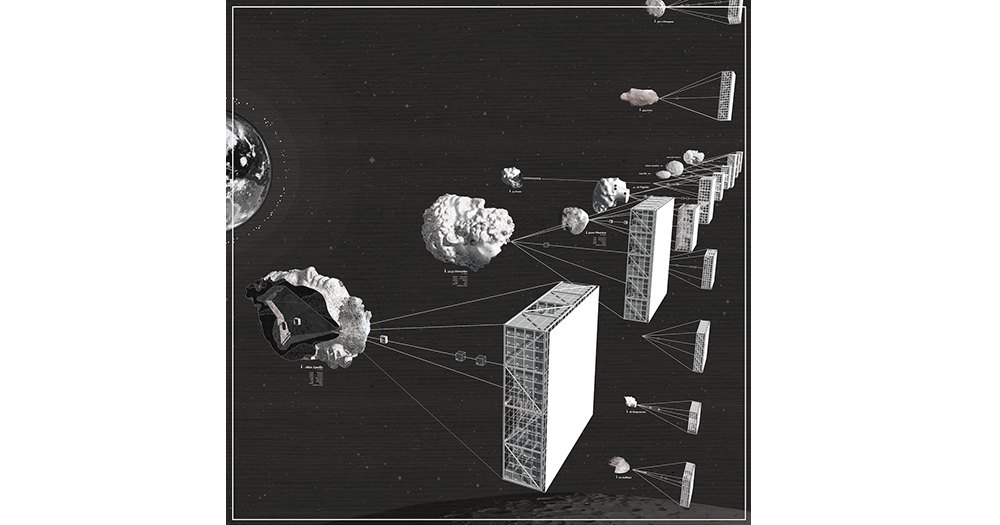The global commons become a synecdoche of a spatial order that legitimatizes geographic violence, dispossession, and extractivism.
[N]o sooner had the contours of the earth emerged as a real globe—not just sensed as myth, but apprehensible as fact and measurable as space—than there arose a wholly new and hitherto unimaginable problem: the spatial ordering of the earth in terms of international law. (1)
Who governs and owns the commons of the earth—the oceans, outer space, and Earth’s atmosphere? The answer “everyone and no one” is the recurring paradox of the planetary commons today. In international law, the global commons are, first, the domains that are not subject to claims of national sovereignty. The enclosure of the Earth into territorial categories divided up the planet around the international legal order of territorial states, with the remainder categories of res nullius, res communis, and common heritage of mankind. (2) The colonial proclamation of terra nullius was used by European states to dispossess Indigenous peoples of their land in the colonies. Res nullius relates thus to territory unclaimed by a sovereign entity state and could be therefore subject to lawful appropriation by a state with the military, political, and economic power to establish and enforce its claim. (3) The latter res communis refers to areas such as the deep seabed, outer space, and Antarctica, which are referred to as global commons and are not subject to the national jurisdiction of a particular state but are shared by other states, if not humanity or the international community as a whole.
In practice, the global commons have been caught in the paradox of modern enclosure. Commons, as David Harvey points out, always implies some degree of enclosure. (4) The opposite concepts of “enclosure” and “commons,” as with all binaries, end up converging, with the former encroaching on and destroying the latter as extractivism intensifies and expands. (5) Once the commons “system” was dismantled in cities and states, it was only a matter of time until the valuation regime, which privileges the internalization of private gains, resource extraction, and ownership claims, progressively scales up to erode planetary domains of protection that had been hitherto been led by laws of exception.
Increasingly open on a “first come, first served basis,” the potential resources of such global commons have become the subject and site of contestation in deeply unequal and unsettled sets of spatial relations in which powerful states and transnational private actors hold the monopoly of violence and diplomacy.
Rather than narratives of the shared good of the planet, the global commons are cautionary tales of global extractivism, of a world order in which the concession is the archetype spatial order of private interests, maybe best qualified as “uncommon interests”.
The crisis of the global commons requires planetary re-presentation; simultaneously the political assembly and the geographic imagination of the Earth. Such a double representational challenge brings forth tensions within the legal concept of the commons as well as divergence or opposition between the globe and the Earth: “There is no planet Earth corresponding to the Promised Land of globalization,” Bruno Latour put it bluntly. (6) Globalization is the abstract space of violent enclosure, extractivism, and uneven flows. And the legal rhetoric that supports and legitimates dispossession of the “global commons” is undergirded by the same spatial imaginary of abstract space and plotted with similar narratives of discovery and epic conquest. If abstract space is first an act of geographical violence through which virtually every space in the world is depopulated, quantified, and exchanged, then an emancipatory spatial imagination counters abstraction on the same ground, by asserting the primacy of the geographic and searching for alternative planetary figures. In her book, In Catastrophic Times, Isabelle Stengers argues that industrial and extractive activities in the service of capital provoked Gaia and produced her current “intrusion.” In terms of political ecology, the planetary figure of Gaia shares with geo- the same etymology from the chtonic divinity Gè. (7) Yet, without the stalemate of disciplinary anchoring, Gaia, Stengers and Latour propose, is a conceptual tool to disquiet, to provoke, to make people think anew about globalism’s ecological violence. (8) For Stengers, the current state of affairs is also maintained by forms of governance that evacuate politics by narrowing the choice of futures to the single infernal alternative of barbarism, of a planet hostage to private interests in a runaway between climate change and a geo-engineered future. The solution to the impasse of such capitalist realism begins with the encounter with Gaia’s intrusion. Away from the obsolete maintenance of a ruptured international order, Stengers’ “cosmopolitical proposal” asks of politics to precisely engage the transgressions and disagreements on how to organize the world as common—things, values, and stories. (9) Learning to see the rupture is to acknowledge that we have learned the codes of globalization and recognize among them modalities of aesthetic resistance and possibilities for the recovery of a “common wealth.” Such reclaiming of the global commons from private interests, however symbolic, begs a political subjectivity with a fundamental commitment to care for the earth—weaving relations that turn the exceptionalism of the global commons, which are intertwined with the planetary imagination, into cautionary tales that produce thinking and feeling of worlds beyond extractivism. They tell the stories of res communis is not to advocate for some protection measures within the global commons. To tell the stories of Antarctica, Outer Space and the ocean seabed is to make evident the sheer wreak and destruction of res nullius throughout, from zones of exception within cities and tribal territories within settler colonial states to the scale of the planet. The global commons become a synecdoche of a spatial order that legitimatizes geographic violence, dispossession, and extractivism .
In response, the following Geostories by Design Earth are speculative fictions that convert into image and narrative the “tragedy of the global commons.” (10) Rather than an image of the globe, these stories summon a geo-politics that is grounded, situated, material, volumetric, populated, heterogeneous, and mythical. In the context of a breakneck climate crisis, such geo-architectural fiction maks public the messy negotiations and power asymmetries of how we inhabit the Earth. A geostory transforms private interests into public controversies; it works as a ‘commoning agent’ in the form of a disjunctive space where incommensurable geographical futures speak to each other. Thus, each of the geostories—ocean floor, Antarctica, outer space—seeks a slightly different awareness of the situation of a global common, not to lament the transgression of another enclosure of the planet, but to put in question the very same infrastructure of private gains that undergirds practices of ecocide throughout the planet .

Fig. 1 Below the Water Towers_Pacific Aquarium
Ocean floor: Pacific aquarium
The ocean seabed is the site of countries and international corporations racing to claim its rare earth mineral resources for the production of batteries and alloys. The 1956 First United Nations Convention of the Law of the Sea reaffirmed that the high seas and seabed were a geography of non-possession, with free access for all. In 1967, Arvid Pardo, the Maltese ambassador to the United Nations, argued that the res communis of the seabed would entail the tragedy of the commons. In order to prevent the “first come, first served’ regime that would have favored advanced industrialized countries, the Global South, and under the auspices of the United Nations, advocated the establishment of an international regime in which any resource extraction would have to benefit the international community as a whole. The seabed that remains outside of national jurisdictions, called the “Area” in the United Nations Convention on the Law of the Sea (UNCLOS), is legally part of the “common heritage of mankind,” which, following UN General Assembly Resolution 2749, should not be subject to national appropriation. The Area is under the legal mandate of the International Seabed Authority (ISA) that was created in 1982 with the mission to oversee exploration, mapping, and resource management in the high seas. Since 2001, however, ISA has granted twelve exploration licenses for minerals on the Clarion-Clipperton Zone deep seabed, an area in the Pacific Ocean approximately the size of Europe and that has the world’s largest deposits of deep-seabed rare earth minerals.

Fig. 2 Hanging Gradens of the Pacific_Pacific Aquarium
The project “Pacific Aquarium” makes visible the externalities of the seabed extraction—plumes, species extinction and proliferation—as well as the promises and limits of currently envisioned geo-engineering solutions. (11)At the ocean floor the sharply toothed, comb-like suction machines churn and rip the ocean surface into sediment slurry, which if not contained would distribute widely through deep ocean currents. In “Below the Water Towers,” A catchment dome caps mining activities to contain sediment plumes. Polluted water is separated from surrounding water and transported into a series of inverted water towers just below the surface for processing. Purified water is gradually released back into the ocean (fig. 1). “Hanging Gardens of the Pacific” responds to ISA mandates the conservation of the flora and fauna in the CCZ mining area. Suspended by cables from a grid of surficial floats, a terraforming infrastructure relocates linear transects of substrate samples to incubate a benthic ecosystem that will be grafted onto the depleted seabed once mining is completed (fig. 2).

Fig. 3 At The Bottom of the World Of Oil and Ice
Antarctica: Of oil and ice
Before the 1957 International Geophysical Year, Antarctica, and based on acts of imperial exploration, five nations—Australia, France, Britain, New Zeeland, and Norway—had laid claims to portions of the Earth’s only continent without a native human population. The 1959 Antarctic Treaty System “froze” national claims to sectors on the Southern Continent and regulated international relations with respect to Antarctica (fig. 3). The treaty, entering into force in 1961 and currently having 50 signatory nations, sets aside Antarctica as a scientific preserve, establishes freedom of scientific investigation and bans military activity on that continent. This includes regimes for the management of fishing resources in the Southern Ocean, as well as a comprehensive environmental protection protocol signed at Madrid in 1991.

Fig. 4 Iceberg Calving_Of Oil and Ice
The project “Of oil and ice” weaves together two concerns brought forth by climate change—melting glaciers in Antarctica and energy intensive desalination industries in the Arabian Gulf—in a proposal to haul icebergs from Antarctica to Hormuz Strait. (12)Antarctica annually calves approximately 93% of the world’s total iceberg mass—an estimated 326 quadrillion gallons of freshwater. Icebergs are res nullius—legally free for the taking without interference from national or international regulatory bodies. A large tabular iceberg, which best resists rolling or tipping, is captured and towed to the Arabian Peninsula at a cost considerably less than that of fresh water from desalination plants (fig. 4). The speculative proposal foregrounds how the future of Antarctica hinges on planetary contracts, such as 2015 Paris Agreement on climate change. If such treaties are not put into effect, the melting of Antarctica promises to be a spectacular vanishing act, with the world’s ears tuned in to a cold seltzer sound—high-pitched hissing, squealing, popping, and creaking with stress under the pressures of international competition over resources (fig. 5).

Fig. 5 Vanishing Continent Act_Of Oil and Ice
Outer space: Cosmorama
In the early 1950s the legal geography of the Earth remained as it had been since the 1648 Peace of Westphalia: the Earth’s land—and the airspace above that land—was the legal possession of states. The Cold War prompted the 1967 Outer Space Treaty, which declared that outer space, including the Moon and other celestial bodies, “shall be the province of mankind” and stipulated that these areas are “not subject to national appropriation by claim of sovereignty, by means of use or occupation, or by any other means.” (13)

Fig. 6 Architecture of the New Space Age_Cosmorama
Space has gained renewed significance with nascent private space commodity initiatives speculating in asteroid mining for water, platinum group metals, and other resource riches.” Dubbed the “New Space Age,” commercial actors such as Space-X and Planetary Resources, are set to mine valuable resources from near-earth asteroids and bring “the natural resources of space within humanity’s economic sphere.” Aside from the daunting logistics, the largest earthbound obstacle to space mining is the 1967 Outer Space Treaty (OST). In a desire to facilitate the expansion of private extractive industries into extra-planetary space, the recent 2015 U.S. SPACE Act, or the Spurring Private Aerospace Competitiveness and Entrepreneurship Act, recognized the right of US citizens to engage in the commercial exploitation of resources in outer space, “First in time, first in right” is again applied to Outer Space.

Fig. 7 Cosmic Rushmore_Cosmorama
Asteroids could be the new equities! From Cosmorama (2018), the triptych “Mining the Sky” describes and speculates on the franchisement of asteroid extraction to private corporations. Drawing together the Architecture of the New Space Age, the conceptual section makes visible the intertwined and conflicting interests of United States, United Nations, and space industry and investors (fig. 6). Robotic arms are used to process the asteroid: they either hollow out the asteroid, collecting the trail of debris in the fabricated cave or mine the surface to carve out the face of the gods of the New Space Age into a cosmic Mount Rushmore constellation (fig. 7).
Photo: Cosmorama by Design Earth at Wrightwood 659. Photo © Tom Harris. Courtesy of Wrightwood 659, the School of the Art Institute of Chicago and the University of Chicago.
Notes:
(1) Schmitt, Carl, Der Nomos der Erde im Völkerrecht des Jus Publicum Europaeum [1950] (English version: The Nomos of the Earth in the International Law of the Jus Publicum Europaeum, New York: Telos Press, 2003, p. 86).
(2) First introduced in the late 1960s as an alternative understanding of jurisdiction that would prevent both appropriation and unbridled exploitation, World Heritage of Mankind requires that the resources of a territory be held and utilized on behalf of the international community as a whole, with special attention to the needs of its most vulnerable members.
(3) Res nullius (in Roman law) were either things unappropriated by anyone, such as things in common, unoccupied lands, wild animals; or things which cannot be appropriated: sacred things dedicated to the celestial gods; religious things dedicated to underworld gods; and sanctified things, such as the walls and gates of a city.
(4) Harvey, David, “The Future of the Commons”, Radical History Review, no. 109, 2011, pp. 101-107.
(5) Blaser, Mario and De la Cadena, Marisol, “The Uncommons: An Introduction”, Anthropologica, no. 59, 2017, pp. 185-193.
(6) Latour, Bruno, “Terroir, Globe, Earth – A New Political Triangle”, www.bruno-latour.fr/sites/default/files/downloads/2016-01-3-TERRITORIES-GB.pdf.
(7) Stengers, Isabelle, Au temps des catastrophes: résister à la barbarie qui vient, Paris: La Découverte, 2009 (English version: In Catastrophic Times: Resisting the Coming Barbarism, Ann Arbor: Open Humanities Press, 2015, p. 54). Also, Stengers, Isabelle, “The Cosmopolitical Proposal”, in Latour, Bruno and Wiebel, Peter (eds.), Making Things Public, Cambridge (MA): The MIT Press, 2005, pp. 994-1003.
(8) Latour, Bruno, “Why Gaia is not a God of Totality”, Theory, Culture & Society, vol. 34, no. 2-3, 2016, pp. 61-81. Also, Aït-Touati, Frédérique and Coccia, Emanuele, Le Cri de Gaïa: penser la Terre avec Bruno Latour, Paris: La Découverte, 2021.
(9) Stengers, Isabelle, In Catastrophic Times, op. cit., p. 54.
(10) Ghosn, Rania and Jazairy, El Hadi, Geostories: Another Architecture for the Environment, New York: Actar, 2018.
(11) Ghosn, Rania and Jazairy, El Hadi, “Leviathan in the Aquarium”, Journal of Architectural Education, vol. 71, no. 2, 2017, pp. 271-279.
(12) Ghosn, Rania and Jazairy, El Hadi, “Of Oil and Ice”, Science Fiction Studies, vol. 45, no. 3, 2018, pp. 433-439.
(13) . See MacDonald, Fraser, “Anti-Astropolitik Outer Space and the Orbit of Geography”, Progress in Human Geography, vol. 31, no. 5, 2007, pp. 592-615. Note: In the same month that OST became open for signature (January 1967), NASA officials visited Antarctica in order to learn about maintaining human exploration in a harsh environment, on one of the two remaining “last frontiers.” Because of its environment, Antarctica was considered an “ideal testing ground” for equipment, infrastructure, and logistics that might be used in outer space.




